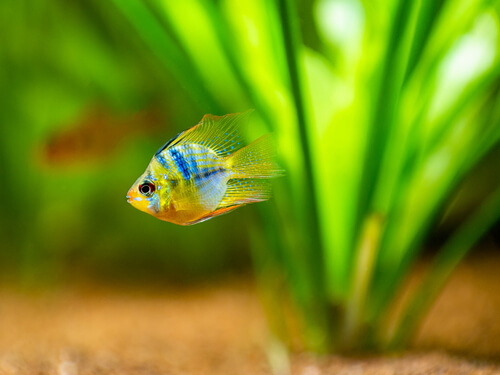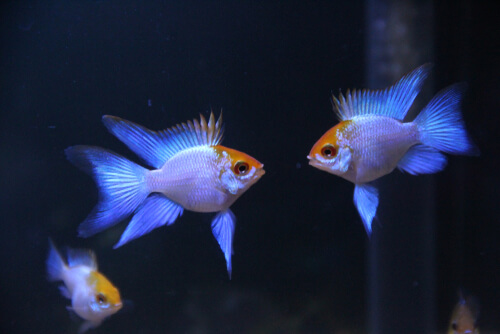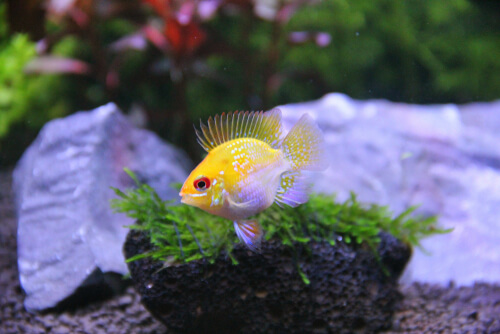Balloon Rams: Care, Appearance & Types, Behavior & More
Posted by on 03/20/2023
We use affiliate links and may receive a small commission on purchases.
Known as a controversial fish, balloon rams are a specialized breed of the more common ram cichlid. Balloon rams have been bred to have a stockier, more round appearance, but they have shorter life expectancies and special care requirements.
In this post, we're going to discuss the three most commonly found balloon rams seen in the aquarium hobby. We'll discuss their overall care, lifespan, and much more so that you can decide where you stand on these controversial fish.
December's Giveaways on Light Fish
Table of Contents
Species Summary
Balloon rams are the result of line breeding Ram cichlids (scientific name: Mikrogeophagus ramirezi) for a more round, balloon-like appearance. Over time, breeders largely from Asia, have singled out male/female pairs with spinal deformities to accentuate their stockier appearance. Similar to the fins of a dumbo betta fish, or the enlarged kok of the Red Dragon Flowerhorn, a genetically-bred balloon-shaped body can lead to negative health implications.
In the wild, a Balloon Ram's naturally-occurring relative, Mikrogeophagus ramirezi can be found swimming in the Orinoco River, which plays host to a diverse group of wildlife, including some of the most popular aquarium fish, such as the Cardinal Tetra and Green Phantom Pleco. Water is slow-moving in their natural habitat, where temperatures tend to be on the warm side, and water alkalinity is considered to be acidic.
Size
Balloon rams are shorter than their wild counterparts and will grow to reach about 2 inches in length, with males being about half an inch larger than females.
In comparison, the standard ram cichlid grows to about 3-4 inches in length.
🛒 Shop Freshwater Fish on Light Fish
Appearance & Types
There are three common types of Balloon Rams, the Blue Balloon, the Electric Blue Balloon, and the German Gold Balloon Ram.
Let's take a look at some of the visual differences between these three types of Balloon Rams.
Blue Balloon Ram
The Blue Balloon Ram, contrary to its name, features a predominantly yellow-colored body, with translucent caudal, dorsal, and anal fins. The Blue Balloon closely resembles the male Ram Cichlid, with the only exception being its round-shaped body.
The "Blue" designation can be attributed to the blue iridescent speckles that can be seen throughout the fish, including underneath the eye, and on all of the fish's fins.

Electric Blue Balloon Ram
Electric Blue Balloon Rams are a short-bodied variant of the more common Electric Blue Ram. They're almost identical in appearance to the Electric Blue Ram, but feature the round body seen in balloon rams.
The Electric Blue Balloon Ram features an orange, torpedo-shaped head, followed by a bright blue opaque body. The bright blue coloration can be seen throughout the fish's fins, except for the pectoral fins, which are translucent.

German Gold Balloon Ram
Arguably the rarest of all three balloon ram color morphs, the German Gold Balloon Ram features a predominantly yellow body with a bright red sclerotic ring . The lower half of the fish's body showcases a white coloration, which extends into the fish's translucent fins.
Similar to other balloon rams, the German Gold Balloon Ram features the same iridescent blue speckles that make the fish stand out in an at-home aquarium.

Male vs Female
Hobbyists looking to distinguish males from females should closely examine their dorsal fins. Male balloon rams tend to have long, spike-like dorsal fins, and a much brighter coloration.
Females tend to be a bit duller in color and will show a black coloration along their pelvic fins.
Balloon Ram Care
Since Balloon Rams are the result of selective breeding, we'll need to look at their naturally occurring relatives to determine their appropriate care requirements. Since the related Ram Cichlid hails from the Orinoco river, we'll want to re-create this environment as closely as possible.
Luckily, ram cichlids are well-documented, and do well when kept in an aquarium environment, so we can expect a similar experience (with some exceptions) when keeping Balloon Rams. One of those exceptions is their average lifespan.
Lifespan
Since Balloon Rams are selectively bred, they're more susceptible to diseases and dietary issues, giving them an average lifespan of about 2-3 years.
In comparison, a standard Ram cichlid tends to average a 4-year lifespan.
Tank Size
We recommend an aquarium that's at least 15 gallons in size for a pair of balloon ram cichlids.
While balloon rams are peaceful compared to other cichlid species, such as the Cuban Cichlid or Red Dragon Flowerhorn, they do tend to be a bit territorial. While they won't nip at the fins of other tank mates, they may chase them around the tank. Hobbyists will greatly benefit from having the extra space if they choose to add additional tank mates in the future.
For hobbyists looking to house a group of Balloon Rams, you'll want to look for a tank that's at least 30 gallons in size, if not larger depending on the quantity being housed.
Water Conditions
Water parameters of a balloon cichlid's native relative, the ram cichlid, tend to be acidic and on the warm side. You'll want to aim for the following water conditions if you plan on keeping balloon rams.
Temperature Range: 78°F-80°F
pH: 6.0-7.5
Ammonia: 0ppm
Nitrite: 0ppm
Nitrate: 0-40ppm
Balloon cichlids can be sensitive to changes in water chemistry, and tend to be quite messy in an aquarium. Weekly 20% water changes are essential, and parameters should always be monitored using a reliable water test kit .
Tank Setup
When first introduced into an aquarium, balloon rams may be quite timid. Having a fully cycled, established tank, with plenty of hardscape such as mopani driftwood and cholla wood will make them feel at ease.
Live aquatic plants will aid in purifying the water column, and durable plants such as flame moss, guppy grass, and hygro can be used to create unique-looking aquascapes.
Substrates such as stratum or bio-stratum work well in a balloon cichlid aquarium, and the nutrient-rich gravel will aid in live plant growth.
Adding an additional powerhead is not needed. Balloon rams prefer the slow-moving currents of their relatives found in nature, and the flow produced by a HOB (hang-on-back) or Canister filter should be sufficient for balloon rams.
An aquarium heater, rated for your tank's size is a must when keeping balloon rams, which prefer warm-water environments.
Common Diseases
Due to being selectively bred for their physical size, Balloon Rams are more susceptible to diseases when compared to other species of freshwater fish. Prevention is essential when keeping balloon rams, and you'll want to actively monitor water quality.
Two of the most common diseases that affect balloon rams are known as Epistylis and Freshwater Ich. While treatable, it's important to notice symptoms and follow best practices when it comes to prevention. We cover the causes, symptoms, and treatment of these diseases in our blog post Epistylis vs Ich: Transmission, Similarities, Differences, and Treatment.
Food & Diet
We recommend feeding Balloon Rams nutrient-rich sinking pellets and algae wafers, 1-2 times per day, no more than what they can consume over a 2-3 minute period.
As bottom-dwelling fish, they'll be a bit hesitant to consume surface-floating foods, but as an occasional treat, you can supplement their diet with frozen bloodworms or freeze-dried brine shrimp.
Behavior and Temperament
Balloon rams aren't nearly as aggressive as african cichlids or other species such as the snow white cichlid. For this reason, they've become a popular choice for a community tank.
Males will be a bit more territorial than females, and you'll want to avoid having another male present in the tank unless you're capable of providing a large tank of at least 30 gallons. Females tend to be much less aggressive. Individual personalities tend to vary between specimens, but it's rare for a balloon ram to physically harm another fish. In most cases, they will chase away any species that choose to infringe on their territory.
Balloon rams tend to hang out along the substrate, often floating in place or searching for potential food sources. They're pretty laid back, and aren't nearly as inquisitive as other fish, like the galaxy koi betta.
Tank Mates
Due to their peaceful temperament, they can co-exist with other similarly sized species.
Some popular tank mates for Balloon Rams include:
-
Cardinal Tetras
You'll want to avoid having multiple male balloon rams in the same tank, and you'll also want to avoid aggressive freshwater species, such as the cuban cichlid, red dragon flowerhorn or electric blue jack dempsey.
While some hobbyists have successfully kept balloon rams with invertebrates, this is a rare occurrence, and unless you're willing to risk it, avoid adding neocaridina color morphs, such as the cherry, blue dream, and orange pumpkin.
Where To Purchase
We've seen balloon rams go up for sale on our marketplace, but they can also be found at LFS (local fish stores) and some of the larger online retailers.
While you're free to do whatever you choose, it's worth considering whether or not perpetuating these fish in the aquarium hobby is the right decision. It's always a good idea to discuss the health and life expectancy of these fish directly with the breeder that's selling them so that you can be as well-informed as possible.
In Conclusion
We hope that by providing some background on these unique-looking fish, you can make an informed decision on whether or not purchasing these fish is the right decision for you. Regardless, of whether you've purchased them or adopted them, it's your responsibility to provide these fish with the highest level of care possible.
Have you experienced caring for a balloon ram? Let us know in the comments, and be sure to visit our marketplace and community forum where you can sell fish, coral, plants, and other aquarium-related products with other hobbyists.
December's Giveaways on Light Fish






